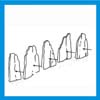From TKWB - Traditional Knowledge World Bank
Jump to navigation
Jump to search
| GENERAL DEFINITION OF THE TECHNIQUE |

|
| Technique: |
STONE ARRANGEMENT AND USE OF SURFACES FOR CATCHMENT |
|
Definition characters description and diffusion
Water harvesting and condensation structures are made up of tiers of stones that catch the winds full of humidity and transmit it to the soil to irrigate the grass for grazing.
General characters description and diffusion
This is how the populations of the villages of the Great Dahalac (Red Sea) still find sustenance today. At the opposite side of the incense route, the caravan city of Shabwa situated deep within the Ramlat as-Sabataynm desert is linked to the South through the port of Qana on the Indian Ocean, and to the North with Gaza on the Mediterranean Sea. Nowadays, that region is completely deserted. The archaeological research and excavations carried out by Jacqueline Pirenne all over the region in 1975 and in 1977 unveiled an endless evidence of water harvesting and condensation devices on the jol, the stone highland at the foot of which the region is situated. According to Pirenne, these structures made up of stones arranged along the edges and of mounds of stones with cavaties inside, were used to catch moisture coming from the ancient palm tree cultivations and orchards surrounding the town of Shabwa. Those methods were passed on by nomadic and transhumant pastoral civilizations that watered the herds and ensured the survival of merchant caravans that used them.
Advantages and sustainability
Water is harvested through the use of condensation structures which catch the humidity in winds and transfer that humiity to the soil, irrigating the grass which is then in turn useful for grazing.
Images
Deepening
|
TRADITIONAL TECHNIQUE DATA
| Technique |
| STONE ARRANGEMENT AND USE OF SURFACES FOR CATCHMENT |
| Icon |
 |
| Cathegory |
| C - Water management |
| Identification code |
| C11c |
| Author: |
|
| Other authors: |
|
| Reference: |
|
|
|